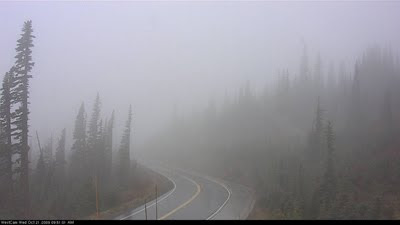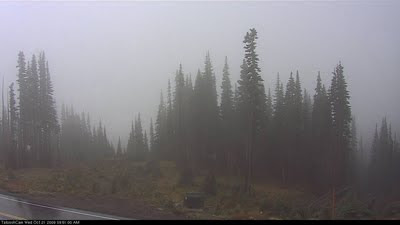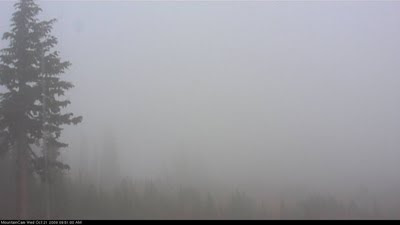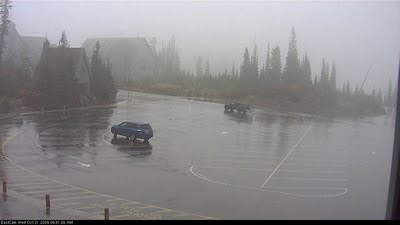The Rocky Mountain Climate Organization (RMCO) and Natural Resources Defense Coucil (NRDC) has released a report, "National Parks in Peril", see
press release. The report covers a number of national parks in the western U.S., including Mt. Rainier NP. While it's hard to argue against the finding and recommendations, and I don't have access to the full suite of data, information, people and resources they had for their conclusions and report, I have to fault a number of issues in it for Mt. Rainier NP.
The report gives a general overview of the potential effect Global Climate Change will have on the NP's with some specific examples from many of the NP's. The report, however, seems to be more a political statement than anything, as the conclusions and recommendations aren't well supported in the report, and some of the references and resouces aren't what might qualify under scientific journalistic standards.
That said, however, I can't argue with most of their recommendations. I can ague some of them aren't environmentally, socially or politically realistic since they're global or national in nature requiring signficant changes in our way of life, and as we've seen in the recent international climate meetings, more talk than show as countries really don't want to address the issues beyond what's commercially successful and profitable.
In short, nice ideas and great hope, but not in my lifetime, or what's left of it. Sadly, my experiece is that we've been hearing this since the mid-1970's and little has been done which really changes things and directions, so advocating greater change now is after the significant damage has already started, and best that can be done is dampen and impacts and effects. And hope that works to level things off when and where change is realistically possible.
As for Mt. Rainier NP in the report? Well, thats' where the report lacks substances and evidence, or at least in the report. And I'll address my opinion here.
First, they mention the November 2006 floods in Washington and specifically Mt. Rainier NP which closed the NP for 6 months. Those floods were significant, but not necessarily unusual for western Washington, including 100-year or large floods. They're more often in recent decades, but for now it's hard to determine the cause beyond just normal changes in the longer term hydrology.
And this flood, along with the floods of the winters of 2007 and 2008, did a lot of damage, namely the Carbon River valley and road, and the Nisqually river valley, road and NPS facilities. But the damage was the result of a major flood on top of decades of channel changes (bed and sediment buildup in the channel) which has raised the channels where any moderate or greater flood would more severly damage the area.
It's wasn't the flood so much as the flood on top of decades of channel aggredation in the lower slopes of the Carbon and Nisqually Rivers in the NP. It was the proverbial disaster waiting to happen and it did with a major flood. But any moderate flood would have also done similar damage. This report doesn't address this fact.
The report lists the following recommendation, "The Congress and the Administration should reestablish within the NPS the cientific and research capacity it had prior to 1993, by returning to NPS the programs and staff transferred that year to the U.S. Geological Survey."
I can't agree, not just because I'm a former USGS scientist, but because the USGS does a better job and has more resources with these research programs, and they write from an unbiased view, something NPS researcher couldn't necessarily accomplish with their research and reports. It is true the NPS would be better focused on the NP's than the USGS, but I would keep the NP research programs where they're currently working.
In the recommendations of the report, they use a graph which indicates what risks effect which NP. With respect to Mt. Rainier, the reports indicates seven risks, which are loss of snow and ice, loss of water, more downpours and floods, loss of plant communities, loss of wildlife, more overcrowding, and loss of fishing.
Well, it's fair to say the conclusions are out on some of these risks because they cite loss than change. What will happen as the NP biologists are finding, is that things are changing. These include changes in forests and forest communities in terms of tree and plant species and distribution of species. There is a discernible invasion of forest into the alpine open areas and meadows.
There will be changes in wildlife species, especially on those who live and need the higher elevations and whos habitat and enviornment requires the current tree and plant communities. There's no question there will be losses, but we can't establish that what know today is the best and is what should continue. We know the past wasn't near what it is today and the whole Mt. Rainier area is in a perpetual state of change.
Let's not forget the whole area of the Puget Sound and western Washington only came out of the Vashon glaciation just 10-12,000 years ago. So what's here now is just phase of change from the past. No doubt it's what we want, but it's not our doing to prevent change, only the type of change.
I agree with the loss of snow and ice. That's long been established for most of the glaciers on Mt. Rainier. Most but not all, and each goes through their own cycle of advance and retreat. If anything, this is probably the greatest risk of Mt. Rainier and the NP, but we have keep in mind the difference between natural and global climate cycles going on. The report doesn't cite any of the on-going research of the USGS on the glaciers of Mt. Rainier.
I don't know if this was an oversight, but much of their research is included in the Masters Degree thresis cited in the report. Either way, this is the greatest risk to the mountain. But that doesn't change the risk they cite of downpours and floods. While the climate model predict a generally warmer climate for Mt. Rainier and the NP, they don't predict a drier climage, and some suggest a wetter climate, more as rain than snow.
This will in turn change the annual hydrologic cycle of the Mountain and the rivers, which could create more frequent floods and drier summer flows from smaller glaciers and less meltwater during the summer. This would in turn effect both the fish and tree/plant species, but we don't know which and how they will adapt over time.
As for overcrowing, that risk been there for the better part of two decades. The NPS is well aware of it and are addressing it in the longterm management programs for the NP. This includes current changes in operation, such as a seasonal shuttle service at Paradise and campground reservation system, and the longer term visitor impacts on those areas, such as Sunrise and Paradise.
But the overcrowding isn't a result of climate change but population growth in the Seattle-Tacoma metropolitan area and the increase in out of state and out of country tourism to the NP. There simply are more people coming to the NP, no matter the cliimate. The problem in the NP is that the increase are predominately in the visitor areas and far less in the backcountry areas. People are visiting, some camping, but fewer hiking.
In the end, I applaud their effort and this report, flaws and all. They raise the issue that we as a nation need to address saving our national parks from ourselves and the global community. This reports adds to the call and the voice. The rest is what takes the hard decisions and work, and the determination, not just to try, but succeed.








